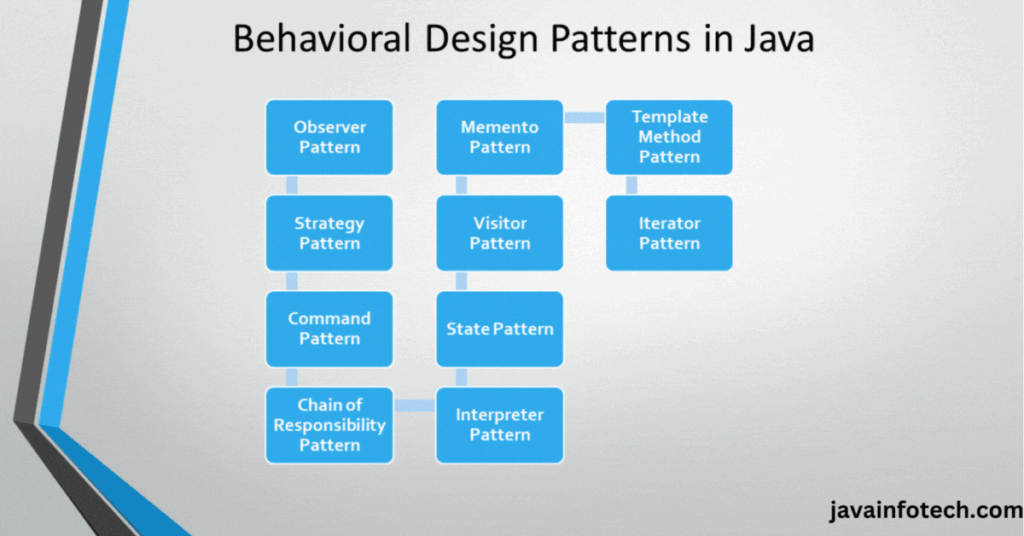In software engineering, behavioral design patterns provide a way to structure communication and interaction between objects, aiding in the effective design and implementation of flexible and reusable software systems. Let’s explore some of the commonly used behavioral design patterns in Java with brief code examples:
1. Observer Pattern: Defines a one-to-many dependency between objects so that when one object changes state, all its dependents are notified and updated automatically.
- Example: The Java built-in
Observerinterface andObservableclass facilitate the implementation of the observer pattern.
// Observer interface
interface Observer {
void update(String message);
}
// Concrete Observer
class ConcreteObserver implements Observer {
@Override
public void update(String message) {
System.out.println("Received message: " + message);
}
}
// Subject (Observable)
class Subject {
private List<Observer> observers = new ArrayList<>();
public void addObserver(Observer observer) {
observers.add(observer);
}
public void notifyObservers(String message) {
for (Observer observer : observers) {
observer.update(message);
}
}
}
2. Strategy Pattern: The strategy pattern allows you to define a family of algorithms and encapsulate them independently so that they can be used interchangeably, making it easy to switch between different strategies.
Code Example:
interface Strategy {
int calculate(int a, int b);
}
class AdditionStrategy implements Strategy {
@Override
public int calculate(int a, int b) {
return a + b;
}
}
class SubtractionStrategy implements Strategy {
@Override
public int calculate(int a, int b) {
return a - b;
}
}
class Context {
private Strategy strategy;
public Context(Strategy strategy) {
this.strategy = strategy;
}
public int calculate(int a, int b) {
return strategy.calculate(a, b);
}
}
public class StrategyPatternDemo {
public static void main(String[] args) {
Context context = new Context(new AdditionStrategy());
System.out.println("Addition result: " + context.calculate(10, 5));
context.setStrategy(new SubtractionStrategy());
System.out.println("Subtraction result: " + context.calculate(10, 5));
}
}3. Chain of Responsibility: Handling Requests Sequentially
In software design, the Chain of Responsibility pattern offers a powerful mechanism to handle requests sequentially across a chain of objects. This pattern is particularly useful when you have a series of objects that can handle a particular request, but you’re unsure which specific object is responsible.
Key Concepts of Chain of Responsibility:
- Request: An object that encapsulates a request to be processed.
- Handler: An object that can handle a specific request or pass it to the next handler in the chain.
- Chain: A sequence of handlers linked together, allowing requests to be passed from one handler to another until one of them handles it.
Java Code Example:
// Request Interface
interface Request {
String getMessage();
}
// Concrete Request
class SimpleRequest implements Request {
private String message;
public SimpleRequest(String message) {
this.message = message;
}
@Override
public String getMessage() {
return message;
}
}
// Handler Interface
interface Handler {
void handleRequest(Request request);
void setNextHandler(Handler next);
}
// Concrete Handler 1
class Handler1 implements Handler {
private Handler next;
@Override
public void handleRequest(Request request) {
if (request.getMessage().startsWith("1")) {
// Handle the request and return
System.out.println("Handler1 processed the request.");
return;
}
if (next != null) {
// Pass the request to the next handler
System.out.println("Handler1 passing the request to Handler2.");
next.handleRequest(request);
}
}
@Override
public void setNextHandler(Handler next) {
this.next = next;
}
}
// Concrete Handler 2
class Handler2 implements Handler {
private Handler next;
@Override
public void handleRequest(Request request) {
if (request.getMessage().startsWith("2")) {
// Handle the request and return
System.out.println("Handler2 processed the request.");
return;
}
if (next != null) {
// Pass the request to the next handler
System.out.println("Handler2 passing the request to Handler3.");
next.handleRequest(request);
}
}
@Override
public void setNextHandler(Handler next) {
this.next = next;
}
}
// Concrete Handler 3
class Handler3 implements Handler {
private Handler next;
@Override
public void handleRequest(Request request) {
if (request.getMessage().startsWith("3")) {
// Handle the request and return
System.out.println("Handler3 processed the request.");
return;
}
}
@Override
public void setNextHandler(Handler next) {
this.next = next;
}
}
// Client
public class Client {
public static void main(String[] args) {
// Create handlers and chain them together
Handler handler1 = new Handler1();
Handler handler2 = new Handler2();
Handler handler3 = new Handler3();
handler1.setNextHandler(handler2);
handler2.setNextHandler(handler3);
// Send requests to the chain
Request request1 = new SimpleRequest("101");
Request request2 = new SimpleRequest("202");
Request request3 = new SimpleRequest("303");
handler1.handleRequest(request1); // Handler1 processed the request.
handler1.handleRequest(request2); // Handler2 processed the request.
handler1.handleRequest(request3); // Handler3 processed the request.
}
}4. Command Pattern: Orchestrating Actions with Simplicity
In the realm of software design, the Command Pattern shines as a powerful tool for decoupling the sender of a request from its receiver. This pattern allows you to encapsulate a request as an object, making it easy to parameterize clients with different requests, queue or log requests, and undo or redo actions.
Key Concepts:
- Command Interface: Defines the common interface for all commands.
- Concrete Commands: Implementations of the Command interface that encapsulate specific actions.
- Invoker: The object that invokes the commands.
- Client: The object that sends commands to the invoker.
Java Code Example:
// Command Interface
interface Command {
void execute();
}
// Concrete Command
class TurnOnLightCommand implements Command {
private Light light;
public TurnOnLightCommand(Light light) {
this.light = light;
}
@Override
public void execute() {
light.turnOn();
}
}
// Concrete Command
class TurnOffLightCommand implements Command {
private Light light;
public TurnOffLightCommand(Light light) {
this.light = light;
}
@Override
public void execute() {
light.turnOff();
}
}
// Invoker
class Switch {
private Command command;
public void setCommand(Command command) {
this.command = command;
}
public void press() {
command.execute();
}
}
// Client
public class Client {
public static void main(String[] args) {
// Create a light
Light light = new Light();
// Create commands
Command turnOnCommand = new TurnOnLightCommand(light);
Command turnOffCommand = new TurnOffLightCommand(light);
// Create an invoker (switch)
Switch switch1 = new Switch();
// Set the command for the switch
switch1.setCommand(turnOnCommand);
// Press the switch to turn on the light
switch1.press();
// Change the command for the switch
switch1.setCommand(turnOffCommand);
// Press the switch to turn off the light
switch1.press();
}
}
In this example, the `Light` class represents the receiver of the commands. The `TurnOnLightCommand` and `TurnOffLightCommand` classes encapsulate the actions of turning on and off the light, respectively. The `Switch` class acts as the invoker, executing the commands when pressed.
The Command Pattern provides a flexible and extensible approach to handling requests, making it a valuable pattern in various scenarios, such as GUIs, event-driven systems, and distributed systems.
These behavioral design patterns offer effective mechanisms for managing communication and interaction among objects in Java applications. By understanding and applying these patterns, developers can create flexible, loosely coupled, and maintainable software systems.


